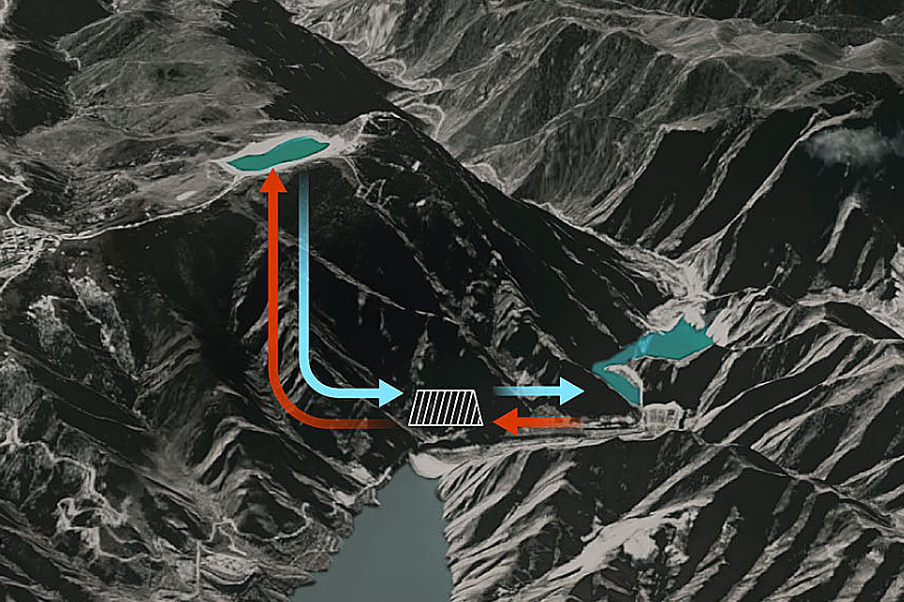The growing appetite for renewable electricity could revive an old technology that has fallen into oblivion: pumped-reserve hydropower plants, which even interest Hydro-Québec.
“It’s part of the range of possible solutions that we are examining to increase the production of our power stations,” said spokesperson for the state-owned company, Maxence Huard-Lefebvre.
Two water reservoirs at different elevations and a turbine in between are all a pumped storage plant needs to produce electricity.
Pumped storage power plants produce electricity like other hydropower plants, but their operation is limited to a few hours at a time: when the highest basin has emptied its water, this water must be pumped up from the lower pelvis upwards.
Hydro-Québec does not have any projects underway, but the Crown corporation specifically mentions pumped-storage plants in its 2022-2026 strategic plan in the possible options for increasing electricity production.
We will study all possible options, including the raising of existing dams, the development of new structures or the construction of pumping stations.
Excerpt from Hydro-Québec’s 2022-2026 strategic plan
These plants are useful during periods of high demand. The turbine operates during peak hours and water from the lower basin can be pumped to the upper basin by the turbine which operates in reverse at night when electricity demand is reduced.
-

PHOTO FROM WIKIPEDIA
Kruonis hydroelectric power station, Lithuania
-

PHOTO FROM WIKIPEDIA
Kruonis hydroelectric power station, Lithuania
1/2
The water contained in the upper basin acts as a battery available when needed and rechargeable outside peak periods. These plants can also be used to balance other intermittent energy sources, such as wind power.
A solution for Quebec?
Quebec does not have a pumped storage plant, but it very nearly had one. In the early 1970s, Hydro-Québec sought to increase its energy production during peak periods, as it does today. The company was seriously considering building such a plant at Fullerton Pond, near Mansonville.
This body of water would have served as an upper basin and a lower basin would have been created, by flooding a portion of the territory downstream estimated at 1.3 square kilometers, according to research carried out for the Potton Heritage Association. The two basins would have been joined by underground pipes.
The project was abandoned in 1980, partly due to opposition from the local population.
The new interest in pumped storage plants is explained by the rising cost of energy and the increase in the need for renewable energy for decarbonization, explains Normand Mousseau, scientific director of the Institute of Trottier Energy at Polytechnique Montreal.

INFOGRAPHIC THE PRESS
Source: Diagram showing the operation of a pumped-storage plant – Hydro-Québec
A pumped storage plant is not the cheapest way to generate electricity, he says. Nor is it a facility that can serve only to satisfy the winter peak. “If it works only a few hours a year, it’s too expensive. It has to work every day. »
It takes energy to pump the water up and up to the upper basin. The idea is to pump water when the demand for energy is at its lowest and to turbine it to produce electricity when it is needed.
With the migration of a growing number of activities from fossil fuels to electricity, Hydro-Québec forecasts a considerable increase in power requirements throughout the year and even more during the winter peak induced by heating.
More power will be needed to support the wind turbines, which will provide the additional electricity that Quebec needs in the short term.
Pumped storage plants are certainly among the options that should be considered by Hydro-Québec, according to Normand Mousseau, especially since its existing reservoirs could be used. By building a reservoir upstream or downstream of the existing reservoirs, the water can be pumped and turbined a second time by the same plant.
It requires investment, but not considerable. It would certainly be less expensive than building new facilities.
Normand Mousseau, scientific director of the Trottier Energy Institute at Polytechnique Montréal
The state corporation has already announced its intention to increase the production of its existing power stations by equipping them with more efficient turbine-generator sets.
Pumping water that has already passed through the turbines so that it can be turbined a second time “is a tool that can make sense in an energy portfolio”, according to Maxence Huard-Lefebvre.

PHOTO FROM WIKIPEDIA
The Sir Adam Beck Hydroelectric Station in Niagara Falls, Ontario
A rebirth
Pumped storage power plants have existed for more than a century and several installations of this type are in operation all over the world, where the geography allows it. Canada has several, including one on the Niagara River in Ontario that is operated by Ontario Power Generation.
Today’s energy-guzzling world seems to have rediscovered this ancient way of producing renewable electricity, according to the Global Energy Monitor, a San Francisco-based NGO that focuses on power generation projects.
The total generation capacity of existing pumped storage plants is 170,000 megawatts and known projects could increase it to almost 500,000 megawatts, according to these specialists.
China leads the way, with 80% of all pumped storage power projects listed worldwide.
Pumped storage plants have a smaller footprint on the landscape than large dams that require flooding large areas, but they are generally not welcome near inhabited areas.
This is the reason why, for example, California dug underground water reservoirs, illustrates Normand Mousseau.
Existing caverns or old mines can also be used to develop reservoirs and pumped storage power plants.
